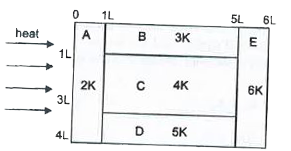The total radiant energy per unit area, normal to the direction of incidence, received at a distance R from the centre of a star of radiys r, whose outer surface radiates as a black body at a temperature T K is given by Solution in Kannada
The correct Answer is:C

Correct choice is (c ).
Topper's Solved these Questions
- BOOK - MODERN PUBLICATIONCHAPTER - TRANSFERENCE OF HEAT EXERCISE - Multiple Choice Questions (Level - II)49videos
TRANSFERENCE OF HEAT
- BOOK - MODERN PUBLICATIONCHAPTER - TRANSFERENCE OF HEAT EXERCISE - Multiple Choice Questions (Level - III) Questions From AIEEE/JEE Examination)5videos
TRANSFERENCE OF HEAT
- BOOK - MODERN PUBLICATIONCHAPTER - SOLIDS & SEMICONDUCTOR DEVICESEXERCISE - Revision Test28videos
SOLIDS & SEMICONDUCTOR DEVICES
- BOOK - MODERN PUBLICATIONCHAPTER - UNIFORM CIRCULAR MOTIONEXERCISE - Revision Test57videos
UNIFORM CIRCULAR MOTION
Similar Questions
Two vessels of different materials are similar in size and other respects. The same quantity of ice filled in them gets melted in 40 and 70 minutes respectively. The ration of thermal conductivities for the materials of boxes is :
03:36View SolutionA composite block is made of slabs A,B,C,D and E of different thermal conductivities (given in terms of a constant K) and sizes (given in terms of length, L) as shown in the figure. All slabs are of same width. Heat 'Q' flows only from left to right through the blocks.
Then in steady state
 02:17View Solution
02:17View SolutionChoose the forward biased p-n junction :
01:59View SolutionA sphere of mass m is tied to end of a string of length 1 and rotated through the other and along a horizontal circular path with speed . The work done in full horizontal circle is:
02:42View SolutionAssuming the sun to have a spherical outer surface of radius r radiating like a black body at temperature t∘C. The power received by a unit surface (normal to the incident rays) at a distance R from the centre of the sun is
where σ is the Stefan's constant.02:36View SolutionThe total radiant energy per unit area, normal to the direction of incidence, received at a distance R from the centre of a star of radius r whose outer surface radiates as a black body at a temperature TK is given by
(where σ is Stefan's constant)06:11View SolutionA black body radiates energy at the rate of E "watt"//m^(2) at a high temperature TK when the temperature is reduced to [(T)/(2)]K Then radiant energy is .
02:05View SolutionA black body radiates energy at the rate of E W/m at a high temperature TK . When the temperature is reduced to T2K , the radiant energy will b
00:59View SolutionThe ratio of radiant energies radiated per unit surface area by two bodies is 16:1, the temperature of hotter body is 1000 K , then the temperature of colder body will be
View Solutionसूर्य को ताप T पर त्रिज्या R का गोला मानने पर इससे r दूरी पर पृथ्वी (त्रिज्या = r0 ) पर आपतित सम्पूर्ण विकिरण शक्ति होगी :
02:16View SolutionA black body radiates energy at the rate of E W//m^(2) at a high temperature T K. When the temperature is reduced to (T/2) K, the radiant energy is
02:51View Solution........... is the amount of radiant power that a unit surface area of the earth would receive in the absence of the atmosphere, when placed at right angles to the incident radiation at a distance of 1 AU.
01:27View SolutionAssuming the sun to have a sphericakl outer surface of radius r radiating like a black body at temperature t0C, the power received by a unit surface, (normal to the incident rays) at distance R from the centre of the sun is
(where σ is the Stefan.s constant)View SolutionAssuming the sun to have a spherical outer surface of radius r radiating like a black body at temperature t∘C. The power received by a unit surface (normal to the incident rays) at a distance R from the centre of the sun is
where σ is the Stefan's constant.02:32View SolutionThe total radiant energy per unit area, normal to the direction of incidence, received at a distance R from the centre of a star of radius r whose outer surface radiates as a black body at a temperature TK is given by
(where σ is Stefan's constant)03:53View Solution

